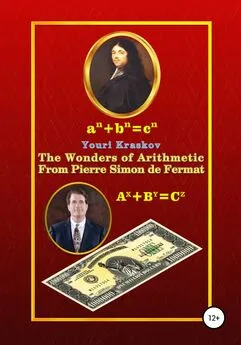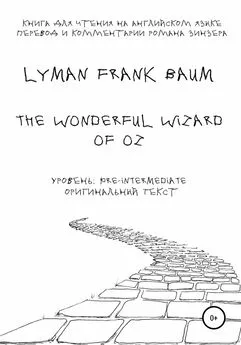Youri Kraskov - The Wonders of Arithmetic from Pierre Simon de Fermat
- Название:The Wonders of Arithmetic from Pierre Simon de Fermat
- Автор:
- Жанр:
- Издательство:неизвестно
- Год:2021
- ISBN:978-5-532-98629-9
- Рейтинг:
- Избранное:Добавить в избранное
-
Отзывы:
-
Ваша оценка:
Youri Kraskov - The Wonders of Arithmetic from Pierre Simon de Fermat краткое содержание
The Wonders of Arithmetic from Pierre Simon de Fermat - читать онлайн бесплатно ознакомительный отрывок
Интервал:
Закладка:
51
The original solution to the Diophantus' task is as follows. “Let it be necessary to decompose the number 16 into two squares. Suppose that the 1st is x 2, then the 2nd will be 16-x 2. I make a square of a certain number x minus as many units as there are in site of 16; let it be 2x-4. Then this square itself is 4x 2–16 x+16. It should be 16-x 2. Add the missing to both sides and subtract the similar ones from the similar ones. Then 5x 2is equal to 16x and x will be equal to 16 fifths. One square is 256/25 and the other is 144/25; both folded give 400/25 or 16 and each will be a square” [2, 27].
52
If c 2= p 2N 2and p 2(as well as any other p i 2of prime factors c) does not decomposed into a sum of two squares i.e. p 2=q 2+r where r is not a square then c 2=p 2(q 2+r)=(pq) 2+p 2r and here in all variants of numbers q and r it turns out that p 2r also is not a square then the number c 2also cannot be the sum of two squares.
53
This discovery was first stated in Fermat’s letter to Mersenne dated December 25, 1640. Here, in item 2-30 it is reported: “ This number (a prime of type 4n+1) being the hypotenuse of one right triangle, its square will be the hypotenuse of two, cube – of three, biquadrate – of four etc. to infinity ". This is an inattention that is amazing and completely unusual for Fermat, because the correct statement is given in the neighbor item 2-20. The same is repeated in Fermat’s remark on Bachet’s commentary to task 22 book III of Arithmetic by Diophantus. But here immediately after this obviously erroneous statement the correct one follows: “ This a prime number and its square can be divided into two squares in only one way; its cube and biquadrate only two; its quadrate-cube and cube-cube only three, etc. to infinity " (see Pt. 3.6). In this letter Fermat apparently felt that something was wrong here, therefore he added the following phrase: “ I am writing to you in such a hurry that I do not pay attention to the fact that there are errors and omit a lot of things, about which I tell you in detail another time ”. This of course, is not that mistake, which could have serious consequences, but the fact is that this blunder has been published in the print media and Internet for the fourth century in a row! It turns out that the countless publications of Fermat's works no one had ever carefully read, otherwise one else his task would have appeared, which obviously would have no solution.
54
Euler's proof is not constructive i.e. it does not provide a method for calculating the two squares that make up a prime of type 4n+1 (see Appendix III). So far, this problem has only a Gauss' solution, but it was obtained in the framework of a very complicated system “Arithmetic of Deductions”. The solution Fermat reported is still unknown. However, see comment 172 in Appendix IV (Year 1680).
55
Methods of calculating prime numbers have been the subject of searches since ancient times. The most famous method was called the "Eratosthenes’ Sieve". Many other methods have also been developed, but they are not widely used. A fragment of Fermat’s letter with a description of the method he created, has been preserved the letter LVII 1643 [36]. In item 7 of the letter-testament he notes: “ I confess that my invention to establish whether a given number is prime or not, is imperfect. But I have many ways and methods in order to reduce the number of divides and significantly reduce them facilitating usual work ." See also Pt. 5.1 with comments 73-74.
56
Fermat discovered formula (2) after transforming the Pythagoras’ equation into an algebraic quadratic equation – see Appendix IV story Year 1652 . However, an algebraic solution does not give an understanding the essence of the resulting formula. This method was first published in 2008 [30].
57
For example, if m = p 1p 2then in addition to the first three solutions there will be others: A 4=p 1; B 4=2p 1p 2 2; A 5=p 2; B 5=2p 1 2p 2; A 6=2p 1; B 6=p 1p 2 2; A 7=2p 2; B 7=p 2p 1 2; A 8=p 1 2; B 8=2p 2 2; A 9=p 2 2; B 9=2p 1 2
58
Formula (7) is called Fermat Binomial . It is curious that the same name appeared in 1984 in the novel "Sharper than the epee" by the Soviet science fiction writer Alexander Kazantsev. This formula is not an identity because in contrast to the identity of Newton Binomial in addition to summands, there is also a sum of them, but with the help of Fermat Binominal it is easy to derive many useful identities in particular, factorization of the sum and difference of two identical powers [30], see also Pt. 4.4.
59
In this case, identity (9) indicates that the same key formula is substituted into the transformed key formula (2) or that the equation (8) we obtained, is a key formula (2) in power n. But you can go the reverse way just give the identity (9) and then divide into factor the differences of powers and such a way you can obtain (8) without using the Fermat Binominal (7). But this way can be a trick to hide the understanding of the essence because when some identity falls from the sky, it may seem that there is nothing to object. However, if you memorize only this path, there is a risk of exposure in a misunderstanding of the essence because the question how to obtain this identity, may go unanswered.
60
Taking into account that c−a=b−2m the expression in square brackets of equation (8) can be transformed as follows: (c++b) n− (a++2m) n= с n-1− a n-1+ c n-2b− a n-22m+ c n-3b 2− a n-3(2m) 2+ … +b n-1− (2m) n-1; с n-1− a n-1= (с − a)(c++a) n-1; c n-2b − a n-22m = 2m(c n-2− a n-2) + c n-2(b − 2m) = (c − a)[2m(c++a) n-2+ c n-2]; c n-3b 2−a n-3(2m) 2= (2m) 2(c n-3− a n-3) + c n-3(b 2− 4m 2) = (c − a)[4m 2(c++a) n-3+ c n-3(b +2m)]; b n-1− (2m) n-1= (b − 2m)(b++2m) n-1= (c − a)(b++2m) n-1All differences of numbers except the first and last, can be set in general form: c xb y− a x(2m) y=(2m) y(c x− a x) + c x[b y− (2m) y] = (c − a)(c++a) x(2m) y+ (b − 2m)(b++2m) yc x= (c − a)[(c++a) x(2m) y+ (b++2m) yc x] And from here it is already become clear how the number (c − a) is take out of brackets. Similarly, you can take out of brackets the factor a + b = c + 2m. But this is possible only for odd powers n. In this case, equation (10) will have the form A iB iC iD i= (2m) n, where A i= c – b = a − 2m; B i= c – a = b − 2m; C i= a + b = c + 2m; D i– polynomial of power n − 3 [30].
61
Equation (10) can exist only if (1) holds i.e. {a n+b n−c n}=0 therefore, any option with no solutions leads to the disappearance of this ghost equation. And in particular, there is no “refutation” that it is wrong to seek a solution for any combination of factors, since A iB i=2m 2may contradict E i=2 n-1m n-2, when equating E ito an integer does not always give integer solutions because a polynomial of power n−2 (remaining after take out the factor c−a) in this case may not consist only of integers. However, this argument does not refute the conclusion made, but rather strengthens it with another contradiction because E iconsists of the same numbers (a, b, c, m) as A i, B iwhere there can be only integers.
62
In this proof, it was quite logical to indicate such a combination of factors in equation (10), from which the Pythagoras’ numbers follow. However, there are many other possibilities to get the same conclusion from this equation. For example, in [30] a whole ten different options are given and if desired, you can find even more. It is easy to show that Fermat's equation (1) is also impossible for fractional rational numbers since in this case, they can be led to a common denominator, which can then be reduced. Then we get the case of solving the Fermat equation in integers, but it has already been proven that this is impossible. In this proof of the FLT new discoveries are used, which are not known to current science: there are the key formula (2), a new way to solve the Pythagoras’ equation (4), (5), (6), and the Fermat Binomial formula (7) … yes of course, else also magic numbers from Pt. 4.3!!!
Интервал:
Закладка:



![О Генри - С высоты козел [From the Cabby's Seat]](/books/1083418/o-genri-s-vysoty-kozel-from-the-cabby-s-seat.webp)






